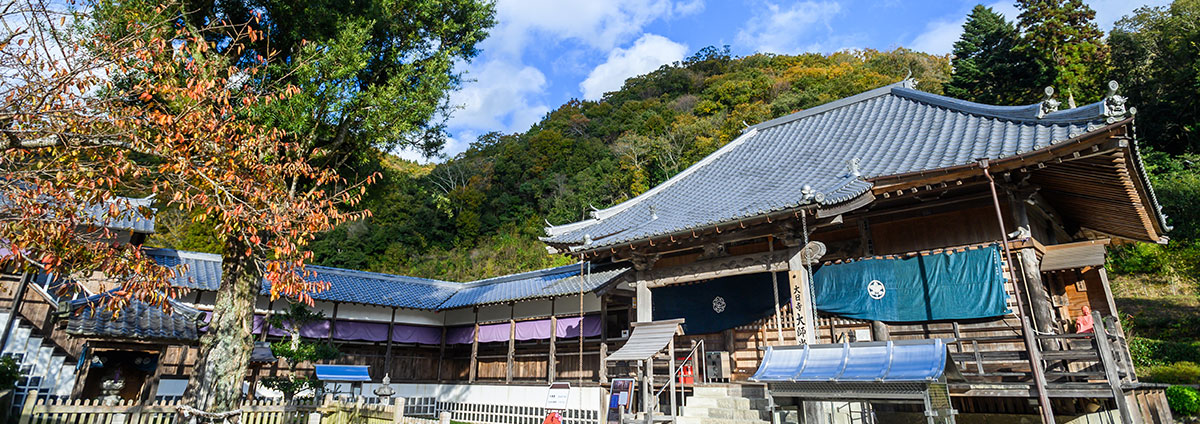

The history and origin
Dainichi-ji Temple is located in the northwestern part of Itano Town, which is in northeastern part of Tokushima Prefecture.
The temple is at the foot of the Asan mountain range, which is on the border between Tokushima and Kagawa Prefectures.
The layout of the temple buildings faces south on the gentle slope of a mountain ridge at a height of around 70 meters, and overlooks the Kurotani-gawa River, which flows to the south from Asan mountain range.
It is said that Kobo-Daishi (Kukai)[*1] felt the presence of Dainichi Nyorai[*2] at this place in 815, and he carved the statue of Dainichi Nyorai as the principal image of the temple. The temple is also named after this Buddha.
The size of statue is said to be about 5.5cm, and Kobo-Daishi prayed three times after every stroke of his blade when he carved the statue (it is ordinarily kept hidden and never unveiled).
This area is surrounded by mountains on three sides, and called “Kuro-dani,” (literally meaning “black valley”). The temple itself had also been called “Kurodani-ji” once.
The sango (an honorific mountain name prefixed to a temple’s name), “Kokugan-zan” (the Chinese Kanji letters meaning “black and steep”) seems to have been the origin of this local name.
Dainichi-ji Temple is now a branch temple of Toji[*3] in Kyoto, but that was after 1887. Before that, the temple belonged to the Shingon Sect Omuro-ha (Ninna-ji Temple is the grand head temple of that sect).
You can see some chrysanthemum crests with 16 petals, which is the crest of the temple, on the eave-end roof tiles and the fretwork of the ranma (transom) at the entrance of the temple hall (kitchen).
The “Shikoku Henrei Reijo Ki” (The book of the Shikoku Pilgrimage) by Jakuhon (1631-1701) published in 1689 says that “there were great temple buildings standing in a row on the grounds of Dainichi-ji Temple once, however, they have been devastated as time has passed.”
The historical record of Tokushima called “Awa-shi,” published in 1815, says that the Buddhist monk Matsu-Hoshi received a message in a dream and renovated the temple during the Oei period (1394-1428).
The temple was again devastated after Matsu-Hoshi’s renovation, and the second feudal lord of Tokushima, Tadateru Hachisuka, donated timber to the temple to build a main hall in 1649, and the temple was restored again in 1681 and 1688. Since then, Tsunanori Hachisuka, the 5th feudal lord in 1692, and Haruaki Hachisuka, the 11th feudal lord in 1799, renovated the temple which still stands to this day.
[*1] Kobo Daishi is the posthumous name of Kukai (774-835), and he is often called “Odaishi-san” affectionately by people living in Shikoku.
[*2] Dainichi Nyorai (Mahavairocana) is regarded as central to Shingon esoteric teachings, therefore, it can be said that Dainichi Nyorai is an entity of the universe and the absolute truth.
[*3] Toji is a temple which was built in the end of 8th century and presented to Kukai by Emperor Saga in 823. The temple was considered as protection for Heian-kyo, the ancient capital Kyoto, and flourished as a training hall of Shingon Esoteric Buddhism. This temple is one of the World Heritage sites in Kyoto, and its five-storied pagoda is well-known.


Temple Information
| Address | 28, Iuchi, Kurodani, Itano-cho, Itano-gun, Tokushima 779-0113, Japan |
|---|---|
| Phone | 088-672-1225 |
| Opens | Gate opens between 6:00 a.m. and 5:00 p.m., the temple office (Nokyosho) opens at 7:00 a.m. |
| Shukubo (pilgrims’ lodgings in a temple) | Not available |
| Parking lot | 20 spaces for cars, 5 spaces for buses (Only available for temple visitors / For free) |